Seven distinct ecosystems
Dune and bluff plants cling to the sand and rocky slopes along the coast, while a rare pine forest occupies an area above them. Moisture loving trees, shrubs, and herbaceous plants line the banks of Waddell Creek, which forms a fresh and salt water marsh before winding it’s way to the Pacific Ocean. Further inland, the valley is dense with redwoods. A diverse forest of evergreen trees grows on the drier adjacent slopes. Many striking flowers appear in each of these ecosystems, with something in bloom nearly year-round.
Species diversity
More than 250 species of birds have been sighted in the valley and on Waddell Beach, including golden and bald eagles, pileated woodpeckers, osprey and snowy plovers. The endangered marbled murrelet, a seabird that flies inland to nest high in the tops of old growth redwoods, also makes its home here. The Waddell Valley is a sanctuary to several other endangered and threatened species, including red-legged frogs, San Francisco garter snakes, steelhead, and Coho salmon.
Fire adaptation
Fire has occurred on the Central Coast for thousands of years, ignited through natural means and intentional burns set by indigenous people. Early Californians saw that carefully set low-intensity fires, known as cultural burns, stimulated a healthier response in vegetation than hotter less frequent blazes.
Many of the plants in Rancho del Oso’s ecosystems have unique adaptions to fire. Some, like Monterey Pines, are even dependent on it – they rely on the heat generated by fire to open their cones and release their seed. The thick bark of Redwood trees is extremely fire resistant. If their branches burn, they are able to regrow new ones (epicormic sprouting). Even if their trunk burns, redwoods have the ability to re-sprout from their root crown. Some trees and large shrubsgrowing in the Mixed Evergreen forest have a similar adaptation.
Smaller shrubs and annual plants disperse abundant seed that can lie dormant for many years until fire clears away dead brush, adding nutrients to the soil through ash and increasing solar exposure. The seed of some rare plants, known as fire followers, can remain viable for up to a century. These plants can be relatively short-lived, and won’t appear again until the next fire passes through.
Ecosystems of Rancho del Oso:
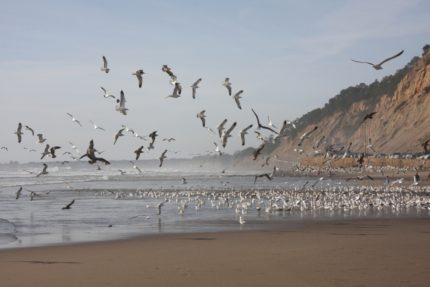 Coastal Strand – beach and dunes
Coastal Strand – beach and dunes
Inhabited predominately by shore birds and plants well adapted to growing in wind, salt spray, and shifting sands. Tide pool dwellers are revealed when the sea recedes from rocky outcroppings at the shore’s edge. Glimpses of marine mammals are also possible from this vantage point.
Species: black tegula (turban snail), California mussel, pink sand verbena, yellow sand verbena, seaside buckwheat, surf scoter, California gull, western gull, brown pelican, snowy plover, sanderling, whimbrel, cliff swallow, Brandt’s cormorant.
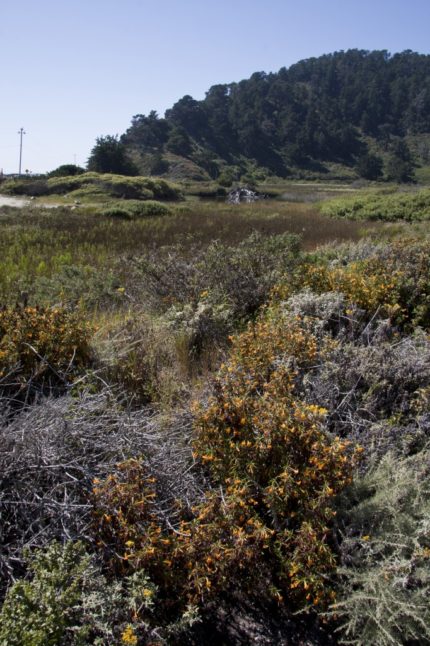 Coastal Scrub – bluffs and open areas next to the beach
Coastal Scrub – bluffs and open areas next to the beach
Plants growing here are low and dense, due to persistent winds. They shelter small mammals, reptiles, and songbirds from sharp-eyed hawks soaring overhead. Once-prevalent coastal prairie species can also be found here. Fragrant foliage is a common feature of this ecosystem, as are flowers in vibrant shades of yellow, orange, and red, appearing in late spring and summer.
Species: coyote brush, sticky monkeyflower, seaside wooly sunflower, California sagebrush, golden yarrow, coyote mint, stinging phacelia, Pacific false bindweed, northern alligator lizard, western fence lizard, coast gartersnake, Santa Cruz gartersnake, California quail, Anna’s hummingbird, spotted towhee.
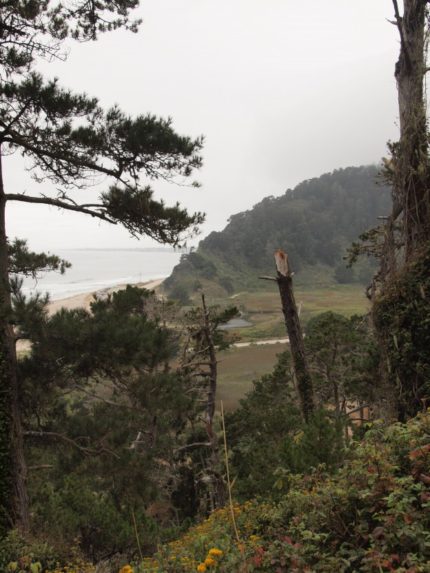 Monterey Pine Forest – slopes near the coast
Monterey Pine Forest – slopes near the coast
Planted for lumber worldwide, the Monterey Pine only occurs naturally in a few places: three small areas in California, and two tiny islands off Baja California in Mexico. The groves found here are near the northernmost extent of the trees’ range. Pitch canker, a fungal disease thought to be spread predominantly by wind and bark beetles, has taken a toll on many trees in recent years.
Species: Monterey Pine, columbine, silver bush lupine, douglas iris, California blackberry, white fairylantern, milkmaids, blue dicks, bracken fern, poison oak, northern alligator lizard, chestnut-backed chickadee, pygmy nuthatch.
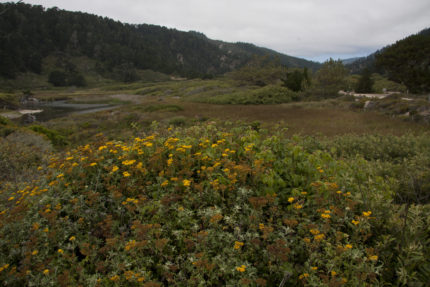 Marsh – low lying areas near the mouth of Waddell Creek
Marsh – low lying areas near the mouth of Waddell Creek
Fish, frogs, and turtles thrive here, as do waterfowl and wading birds. Plants like rushes and sedges, that prefer to keep their roots wet, are abundant. On the periphery, footprints of raccoon and other mammal visitors decorate the mud.
Species: California red-legged frog, western pond turtle, California newt, marsh baccharis, cow parsnip, California aster, giant vetch, sierran chorus frog, mallard, American coot, great egret, snowy egret, great blue heron, marsh wren, common goldeneye, black phoebe.
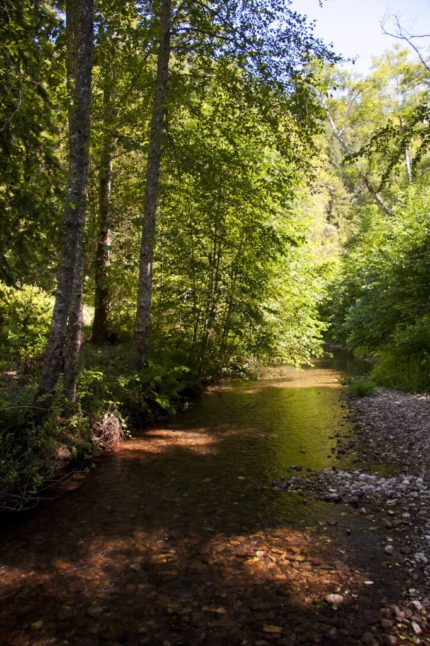 Riparian zone – vegetation along Waddell Creek
Riparian zone – vegetation along Waddell Creek
Fish inhabit the deeper pools, while birds and mammals quench their thirst in the shallows, and insects hover just above the surface. Moisture loving trees, shrubs, and herbs grow along the banks, providing shade, shelter, and food, around these important fresh water sources.
Species: willow, red alder, cottonwood, great horsetail, elk clover, California hedgenettle, California bee plant, western pond turtle, California newt, sierran chorus frog, California red-legged frog, Townsend’s warbler, yellow-rumped warbler, Pacific slope flycatcher, violet-green swallow.
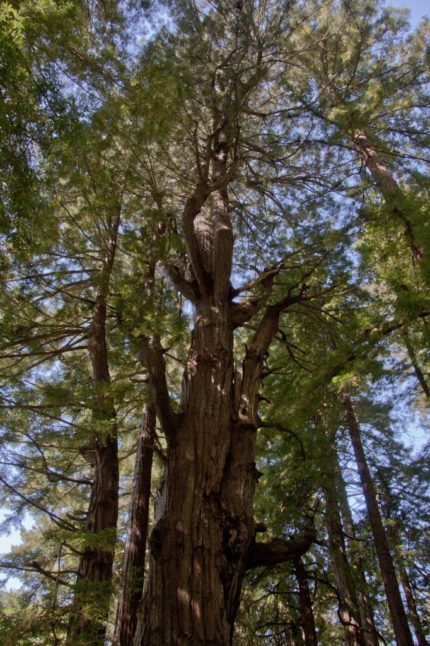 Redwood Forest – valley floor and shaded slopes above
Redwood Forest – valley floor and shaded slopes above
Redwoods are thought to be the tallest trees in the world. They supplement water received from rainfall by collecting fog drip with their needles, which in turn form a thick mulch on the forest floor, further conserving moisture. Plants and animals seeking damp shade – from ferns and berries to banana slugs and newts – dwell on the forest floor. Other species take cover in the trees’ abundant foliage.
Species: coast redwood, trillium, banana slug, varied thrush, hound’s tongue, western bleeding heart, false soloman’s seal, checker lily, redwood violet, western sword fern
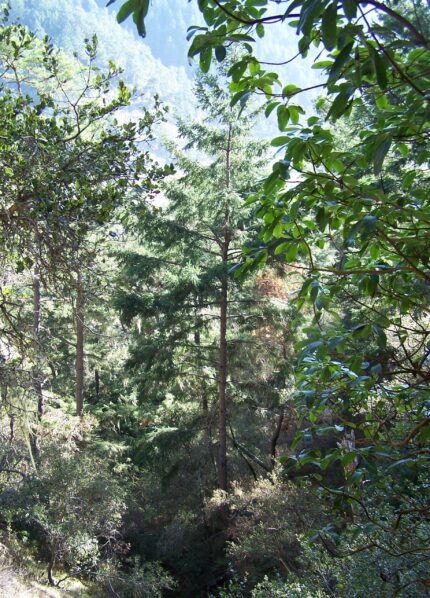 Mixed Evergreen Forest – sunnier, drier slopes above the valley floor
Mixed Evergreen Forest – sunnier, drier slopes above the valley floor
Evergreen trees dominate the canopy of this extensive and diverse plant community. Birds and mammals find abundant food and shelter options here .
Species: Oak, madrone, tanoak, douglas fir, bay laurel, cypress, toyon, coffee berry, ceanothus, manzanita, nightshade, Douglas iris, globe lily, coyote mint, great-horned owl, acorn woodpecker, stellar jay.
